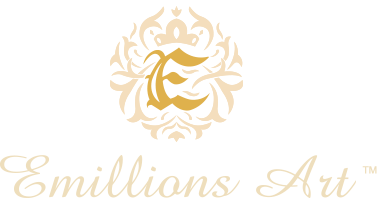Abstract art is somehow both the focus of our attention and the mirror of our focus — it lets us see what we want. When we take the time to live and breathe in the presence of abstract works they begin to take on a new depth and life beyond what the casual viewer may notice.
Take, for example, the “Fresh Paint” series by Jane Davies. These works seem to combine dissonant, vibrant colors in ways that entrance the eyes and seduce the soul. The space created between the strokes can, at times, feel like falling into the center of a beating heart.

Jackson Pollock’s No. 5, 1948, uses a veritable web of color and designto depict the intricacy that entangles the conscious mind. Pollock’s revolutionary and innovative technique altered the definition of what fine art could and should be. He was unique even in his approach to the work. Pollock didn’t sketch or test his paintings in advance; he let them be spontaneously birthed from emotion. His impromptu style is itself one very important component of abstract work: the capturing of emotion.
From Pollock-style drip painting to mixed media and installation works, abstract art runs the gamut of medium and scale. In order to explore this art form that some say extends all the way back to the prehistoric cave paintings of eight-legged bison, we reached out to an up-and-coming abstract artist to explore his perspectives.
Alastair Blake Peters is a Pennsylvania-based artist who creates large-scale, abstract works. Receiving his Bachelors of Fine arts from the Tyler School of Art, Temple University, in Philadelphia and studying for a time in Rome, Italy, Peters has been a practicing abstract artist for over a decade.

“Chex” (2016) Alastair Blake Peters
He describes the tenants of his philosophy in this short poem: There is always an unknown frontier at hand. Begin. Respond to the commitments. Balance. Not everything must be understood. Known unknowns will resonate. No fear. Proceed and explore — new is found in uncertainty.
This is a fantastic representation of the mental state of the artist standing in front a giant blank surface. The answer to his question, “where to begin?” is in one simple statement — “Begin.”
Says Peters of his process — his way of beginning, “I purchase the raw materials and build my own canvas strainers. The waiting and time spent creating the ‘wall’ on which I will discover the artwork provides a healthy longing up until the moment I begin painting.”
When asked what drew him to this style of work, Alastair replies, “I work abstractly to have immediacy, freedom and directness. Beginning with an impulse and realizing the destination once I have arrived. In many ways abstraction is more pure and literal than a traditional image of ‘realism.’ The ideas do not need to be forced into what is seen in a typical environment, but can instead create a language that makes visible a truth that may have been true only in the back of the mind.”
One of the curious concepts revolving around abstract art is accessibility. While art critics, collectors and investors alike continue to affirm these works are worth their weight in market share and monetary value, the general public is often confounded by abstract art.

“It’s Pretty”, Alastair Blake Peters
With realism or figurative art, the viewer can look and see exactly what is being represented and make their own assessment as to the talent and expertise of the artist. But abstract works require a different sort of engagement from the viewer. They offer the chance to see one’s self. To see one’s self in an abstract piece requires knowing one’s self — an inward journey many spend their lives avoiding.
Still, there is a visceral, emotional accessibility living in these wonderful works that draws many into their world of color and meaning.
Peters describes pieces that deeply impacted him and explains why they are prime examples of highly, emotionally engaging abstract art.
“Robert Rauschenberg’s Combines show at the Metropolitan Museum of Art in New York City was one of the first experiences where I began to recognize what I was connecting with in the abstract works. The selection and arrangement of objects felt so beautifully placed. I saw deep ties to an individual’s life and emotional responses to events experienced. They were like poems.”
His wistful, poignant and personal insights continue, “Some of the works seemed to depict emotions that I held strongly in memory. I felt at home.”

“The Fire That Consumes All Before It” (1978) Cy Twombly
“Another artist whose work I connect with is Cy Twombly. His installation, Fifty Days at Iliam at the Philadelphia Museum of Art speaks volumes to me. The methods used to create the works connect with unbridled emotion. The body is physically engaged. You can see the humanity in the creation of the 10 paintings which are depicting a story of humanity at war. There is speed and romance, melancholy and violence. The paintings have you circled in as they tell of the tragedy and loss that consumed many soldiers.”
There are myriad perspectives on the topic of emotion in art — many opposing, all valid. The breadth of the human experience, the depth to which we hold the value of our life experiences dictate how we respond when feelings and memories of those experiences are evoked.
Abstract art creates a platform from which we can dive into the murky waters of our emotional past — the pool of our understanding of the world around us. It makes sense that abstract art can be surrounded by angst and debate, passion and passive dismissal.
Alastair describes perfectly the moment of revelation that can happen with these wonderful works, “Running into a work of art that speaks to you can feel like meeting someone for the first time and discovering that they understand you because you shared similar experiences throughout your life.”
“Sometimes a work of abstract art displays certain traits that resonate with how a person has been seeing the world, but who didn’t have a succinct way to express it for themselves. Abstraction speaks in languages that are true, though it might not feel like the native tongue of the observer on first glance.”
For more perspectives on abstract art and the artists who dwell in this genre, Emillions presents MM Ciciovan, Nicholas Broughton, Lori Dubois, Al Diaz, Monique Frydman, Andreas Nottebohm, Shray, Marie-Aude St. Michel, Peter Rujuwa and Gianfranco Meggiato—all practitioners of abstract works. Our featured photographers, Ricardo Jorge Reis, Ryan Saevitz, and Dennis Sabo, integrate abstract principles in photography, extracting abstraction from their surroundings. It’s all about perspective.



